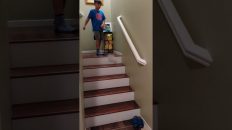In a nondescript room filled with blinking lights and whirring machinery, the scene is set for an unusual yet potentially transformative experience—a session with a helpful lie detector. The protagonist, let’s call him Alex, settles into a comfortable chair, surrounded by monitors displaying graphs and data points that promise to reveal more than words alone ever could.
Doing a Helpful Lie Detector
Alex’s examiner, Dr. Patel, a seasoned polygraph expert with a reassuring demeanor, explains the process calmly. The lie detector, an advanced piece of technology that measures physiological responses such as heart rate, perspiration, and respiration, is poised to uncover truths that might otherwise remain hidden.
As the electrodes are gently applied to Alex’s fingertips and chest, the room fills with a soft hum of anticipation. Dr. Patel’s soothing voice offers reassurance, emphasizing that the lie detector isn’t just about catching falsehoods but also about understanding deeper truths and facilitating honesty.
With a nod of readiness, Dr. Patel initiates the questioning phase. The first series of inquiries are innocuous, designed to establish a baseline for Alex’s physiological responses. “Are you currently sitting down?” Dr. Patel asks, his voice measured and neutral. Alex responds affirmatively, feeling a slight flutter of nerves despite his confidence.
As the session progresses, the questions delve deeper. “Did you really complete your assignment last week?” Dr. Patel probes gently, watching the monitors intently for any subtle changes in Alex’s physiological responses. Alex hesitates for a moment, his mind racing as he recalls the specifics of that busy week.
In a nondescript room filled with blinking lights and whirring machinery, the scene is set for an unusual yet potentially transformative experience—a session with a helpful lie detector. The protagonist, let’s call him Alex, settles into a comfortable chair, surrounded by monitors displaying graphs and data points that promise to reveal more than words alone ever could.
Alex’s examiner, Dr. Patel, a seasoned polygraph expert with a reassuring demeanor, explains the process calmly. The lie detector, an advanced piece of technology that measures physiological responses such as heart rate, perspiration, and respiration, is poised to uncover truths that might otherwise remain hidden.
As the electrodes are gently applied to Alex’s fingertips and chest, the room fills with a soft hum of anticipation. Dr. Patel’s soothing voice offers reassurance, emphasizing that the lie detector isn’t just about catching falsehoods but also about understanding deeper truths and facilitating honesty.
With a nod of readiness, Dr. Patel initiates the questioning phase. The first series of inquiries are innocuous, designed to establish a baseline for Alex’s physiological responses. “Are you currently sitting down?” Dr. Patel asks, his voice measured and neutral. Alex responds affirmatively, feeling a slight flutter of nerves despite his confidence.
As the session progresses, the questions delve deeper. “Did you really complete your assignment last week?” Dr. Patel probes gently, watching the monitors intently for any subtle changes in Alex’s physiological responses. Alex hesitates for a moment, his mind racing as he recalls the specifics of that busy week.
In a nondescript room filled with blinking lights and whirring machinery, the scene is set for an unusual yet potentially transformative experience—a session with a helpful lie detector. The protagonist, let’s call him Alex, settles into a comfortable chair, surrounded by monitors displaying graphs and data points that promise to reveal more than words alone ever could.
Alex’s examiner, Dr. Patel, a seasoned polygraph expert with a reassuring demeanor, explains the process calmly. The lie detector, an advanced piece of technology that measures physiological responses such as heart rate, perspiration, and respiration, is poised to uncover truths that might otherwise remain hidden.
As the electrodes are gently applied to Alex’s fingertips and chest, the room fills with a soft hum of anticipation. Dr. Patel’s soothing voice offers reassurance, emphasizing that the lie detector isn’t just about catching falsehoods but also about understanding deeper truths and facilitating honesty.
With a nod of readiness, Dr. Patel initiates the questioning phase. The first series of inquiries are innocuous, designed to establish a baseline for Alex’s physiological responses. “Are you currently sitting down?” Dr. Patel asks, his voice measured and neutral. Alex responds affirmatively, feeling a slight flutter of nerves despite his confidence.
As the session progresses, the questions delve deeper. “Did you really complete your assignment last week?” Dr. Patel probes gently, watching the monitors intently for any subtle changes in Alex’s physiological responses. Alex hesitates for a moment, his mind racing as he recalls the specifics of that busy week.
In a nondescript room tucked away in the heart of a bustling city, the atmosphere hums with anticipation as Alex settles into a plush chair, surrounded by an array of blinking lights and sleek, high-tech machinery. Dr. Patel, a seasoned polygraph examiner with a reassuring demeanor, stands nearby, overseeing the setup with practiced efficiency. The room is bathed in a soft, ambient glow, casting gentle shadows across the monitors that line the walls, each displaying intricate graphs and data points.
As Alex adjusts to the sensation of electrodes being delicately placed on his fingertips and chest, he feels a mix of curiosity and apprehension. The lie detector, an impressive piece of technology designed to measure physiological responses such as heart rate, perspiration, and respiration, stands ready to decode the subtle signals of truth or deception.
Dr. Patel’s voice cuts through the quietude, calm and methodical as he explains the procedure. His words carry a reassuring cadence, emphasizing that the lie detector isn’t merely a tool of interrogation, but a means to uncover deeper truths and foster transparency. “This isn’t about catching you out,” he assures Alex with a smile, “it’s about helping you understand yourself better.”
With a nod of agreement, Alex takes a deep breath, preparing himself for the questions that will follow. The initial inquiries are simple, intended to establish a baseline for his physiological responses. “Are you currently sitting down?” Dr. Patel asks, his voice steady and neutral. Alex nods, feeling the cool air against his skin and the soft cushion beneath him.
As the session progresses, the questions become more probing. “Did you complete your assignment last week?” Dr. Patel asks, his gaze gentle yet probing. Alex hesitates briefly, recalling the details of a particularly hectic week. His mind races as he replays the events, the deadlines, and the moments of distraction that may have impacted his work.
The lie detector measures his responses with precision, capturing subtle changes in his heartbeat and skin conductance. With each question, Alex’s thoughts and emotions play out in real-time on the monitors, offering a glimpse into the complexities of human honesty and self-perception.
In this moment, the lie detector becomes more than a machine; it serves as a mirror, reflecting truths that lie beneath the surface. As Dr. Patel continues to guide the session with empathy and insight, Alex begins to appreciate the power of this technology not just to detect falsehoods, but to facilitate personal growth and understanding.
Together, in the quiet intimacy of the examination room, Alex and Dr. Patel embark on a journey of discovery—one where honesty, introspection, and the quest for truth intersect in profound ways. And as the session unfolds, both examiner and examinee alike are poised to uncover not only the answers to specific questions, but perhaps deeper insights into the human condition itself.
In a nondescript room tucked away in the heart of a bustling city, the atmosphere hums with anticipation as Alex settles into a plush chair, surrounded by an array of blinking lights and sleek, high-tech machinery. Dr. Patel, a seasoned polygraph examiner with a reassuring demeanor, stands nearby, overseeing the setup with practiced efficiency. The room is bathed in a soft, ambient glow, casting gentle shadows across the monitors that line the walls, each displaying intricate graphs and data points.
As Alex adjusts to the sensation of electrodes being delicately placed on his fingertips and chest, he feels a mix of curiosity and apprehension. The lie detector, an impressive piece of technology designed to measure physiological responses such as heart rate, perspiration, and respiration, stands ready to decode the subtle signals of truth or deception.
Dr. Patel’s voice cuts through the quietude, calm and methodical as he explains the procedure. His words carry a reassuring cadence, emphasizing that the lie detector isn’t merely a tool of interrogation, but a means to uncover deeper truths and foster transparency. “This isn’t about catching you out,” he assures Alex with a smile, “it’s about helping you understand yourself better.”
With a nod of agreement, Alex takes a deep breath, preparing himself for the questions that will follow. The initial inquiries are simple, intended to establish a baseline for his physiological responses. “Are you currently sitting down?” Dr. Patel asks, his voice steady and neutral. Alex nods, feeling the cool air against his skin and the soft cushion beneath him.
As the session progresses, the questions become more probing. “Did you complete your assignment last week?” Dr. Patel asks, his gaze gentle yet probing. Alex hesitates briefly, recalling the details of a particularly hectic week. His mind races as he replays the events, the deadlines, and the moments of distraction that may have impacted his work.
The lie detector measures his responses with precision, capturing subtle changes in his heartbeat and skin conductance. With each question, Alex’s thoughts and emotions play out in real-time on the monitors, offering a glimpse into the complexities of human honesty and self-perception.
In this moment, the lie detector becomes more than a machine; it serves as a mirror, reflecting truths that lie beneath the surface. As Dr. Patel continues to guide the session with empathy and insight, Alex begins to appreciate the power of this technology not just to detect falsehoods, but to facilitate personal growth and understanding.
Together, in the quiet intimacy of the examination room, Alex and Dr. Patel embark on a journey of discovery—one where honesty, introspection, and the quest for truth intersect in profound ways. And as the session unfolds, both examiner and examinee alike are poised to uncover not only the answers to specific questions, but perhaps deeper insights into the human condition itself.
In a nondescript room tucked away in the heart of a bustling city, the atmosphere hums with anticipation as Alex settles into a plush chair, surrounded by an array of blinking lights and sleek, high-tech machinery. Dr. Patel, a seasoned polygraph examiner with a reassuring demeanor, stands nearby, overseeing the setup with practiced efficiency. The room is bathed in a soft, ambient glow, casting gentle shadows across the monitors that line the walls, each displaying intricate graphs and data points.
As Alex adjusts to the sensation of electrodes being delicately placed on his fingertips and chest, he feels a mix of curiosity and apprehension. The lie detector, an impressive piece of technology designed to measure physiological responses such as heart rate, perspiration, and respiration, stands ready to decode the subtle signals of truth or deception.
Dr. Patel’s voice cuts through the quietude, calm and methodical as he explains the procedure. His words carry a reassuring cadence, emphasizing that the lie detector isn’t merely a tool of interrogation, but a means to uncover deeper truths and foster transparency. “This isn’t about catching you out,” he assures Alex with a smile, “it’s about helping you understand yourself better.”
With a nod of agreement, Alex takes a deep breath, preparing himself for the questions that will follow. The initial inquiries are simple, intended to establish a baseline for his physiological responses. “Are you currently sitting down?” Dr. Patel asks, his voice steady and neutral. Alex nods, feeling the cool air against his skin and the soft cushion beneath him.
As the session progresses, the questions become more probing. “Did you complete your assignment last week?” Dr. Patel asks, his gaze gentle yet probing. Alex hesitates briefly, recalling the details of a particularly hectic week. His mind races as he replays the events, the deadlines, and the moments of distraction that may have impacted his work.
The lie detector measures his responses with precision, capturing subtle changes in his heartbeat and skin conductance. With each question, Alex’s thoughts and emotions play out in real-time on the monitors, offering a glimpse into the complexities of human honesty and self-perception.
In this moment, the lie detector becomes more than a machine; it serves as a mirror, reflecting truths that lie beneath the surface. As Dr. Patel continues to guide the session with empathy and insight, Alex begins to appreciate the power of this technology not just to detect falsehoods, but to facilitate personal growth and understanding.
Together, in the quiet intimacy of the examination room, Alex and Dr. Patel embark on a journey of discovery—one where honesty, introspection, and the quest for truth intersect in profound ways. And as the session unfolds, both examiner and examinee alike are poised to uncover not only the answers to specific questions, but perhaps deeper insights into the human condition itself.
In a nondescript room tucked away in the heart of a bustling city, the atmosphere hums with anticipation as Alex settles into a plush chair, surrounded by an array of blinking lights and sleek, high-tech machinery. Dr. Patel, a seasoned polygraph examiner with a reassuring demeanor, stands nearby, overseeing the setup with practiced efficiency. The room is bathed in a soft, ambient glow, casting gentle shadows across the monitors that line the walls, each displaying intricate graphs and data points.
As Alex adjusts to the sensation of electrodes being delicately placed on his fingertips and chest, he feels a mix of curiosity and apprehension. The lie detector, an impressive piece of technology designed to measure physiological responses such as heart rate, perspiration, and respiration, stands ready to decode the subtle signals of truth or deception.
Dr. Patel’s voice cuts through the quietude, calm and methodical as he explains the procedure. His words carry a reassuring cadence, emphasizing that the lie detector isn’t merely a tool of interrogation, but a means to uncover deeper truths and foster transparency. “This isn’t about catching you out,” he assures Alex with a smile, “it’s about helping you understand yourself better.”
With a nod of agreement, Alex takes a deep breath, preparing himself for the questions that will follow. The initial inquiries are simple, intended to establish a baseline for his physiological responses. “Are you currently sitting down?” Dr. Patel asks, his voice steady and neutral. Alex nods, feeling the cool air against his skin and the soft cushion beneath him.
As the session progresses, the questions become more probing. “Did you complete your assignment last week?” Dr. Patel asks, his gaze gentle yet probing. Alex hesitates briefly, recalling the details of a particularly hectic week. His mind races as he replays the events, the deadlines, and the moments of distraction that may have impacted his work.
The lie detector measures his responses with precision, capturing subtle changes in his heartbeat and skin conductance. With each question, Alex’s thoughts and emotions play out in real-time on the monitors, offering a glimpse into the complexities of human honesty and self-perception.
In this moment, the lie detector becomes more than a machine; it serves as a mirror, reflecting truths that lie beneath the surface. As Dr. Patel continues to guide the session with empathy and insight, Alex begins to appreciate the power of this technology not just to detect falsehoods, but to facilitate personal growth and understanding.
Together, in the quiet intimacy of the examination room, Alex and Dr. Patel embark on a journey of discovery—one where honesty, introspection, and the quest for truth intersect in profound ways. And as the session unfolds, both examiner and examinee alike are poised to uncover not only the answers to specific questions, but perhaps deeper insights into the human condition itself.








Compellingly monetize focused architectures after efficient methodologies. Quickly provide access to fully researched users vis-a-vis client-focused metrics. Credibly envisioneer sustainable results and process-centric bandwidth. Proactively build.
Dramatically maximize value-added synergy after timely information. Rapidiously coordinate global.